Eaton Canyon
Be Your Own Tour Guide
Have fun discovering the plants, geology, and some of the animals (we hope!) of the Eaton Canyon nature preserve. But first…

Like all good naturalists, you will always
- Bring plenty of water when you hike
- Stay on the trail
- Dispose in a trash can — or take home — every bit of trash
- Pick up after your (leashed!) dog
- Leave everything where you found it
Feather, flower, rock, or bark; leave all nature in the park.
And never feed, chase, or try to touch animals. The canyon is their home.
Let’s start by looking for the geological story
- steep mountainsides
The San Gabriel Mountains are considered a very young range, pushed up from below only five to ten million years ago (40 – 50 million years AFTER the last dinosaur!). In geologic time, they have not had much time to erode, so are still very steep and angular.
- many smooth rocks
The arroyo is dry most of the time, but when it rains, fast-flowing water tosses and tumbles rocks that fell from the steep hillsides, and, over time, smooths their rough edges.
- a large boulder
Every few decades or so, the canyon experiences hard rain and severe flooding, since all the side canyons of the local watershed empty through here. Water is powerful, and as you can see, has delivered many large boulders far downstream.
- a rocky, wide arroyo
In winter rains, water from the mountains above drains through the arroyo, sometimes as a deep, rushing flood that spreads far outside its usual area. From here it flows (often underground) to the Rio Hondo River and on to the Los Angeles River and then to the ocean.



Eaton Canyon’s Special Rocks
You’ll only find this exact mineral composition:
Lowe Granodiorite (Dalmatian rock)
Wilson quartz diorite (salt & pepper)


If you see this boulder…
If it’s a warm, sunny day, feel both sides, light and dark. Do you feel a difference? Why do you think that is?


Do you know the name of these mountains?
Our steep and beautiful mountains are the San Gabriel Mountains
You might also see
- a fallen tree trunk. Notice how many animals are using it for food or shelter. Is fungus helping it decompose?
- a hole in the ground. Large? Maybe a ground squirrel made it. Others (snakes, lizards, mice) might be using it now. Small? Maybe ants live there.
- scat (poop, often dried). Animal scat shows what the animal, such as coyote or fox ate
- rocks, large and small. Many different minerals make them up. Do you see pink or green? Shiny bits? Stripes? What else do you notice?
- a bridge (about a mile along the trail). Originally built in the early 1900s to transport a telescope up to Mt. Wilson
- a road climbing up the mountainside
- Also built for telescope transport; hikers use it now.
- Ask yourself as you walk and learn: What are some of the reasons that, for hundreds of years, the Tongva people chose to live (at least part of the year) in this canyon?

Listen for
- a quail
- (it sounds like, “Chicago, Chicago”)
- an acorn woodpecker
(sounds like a loud “waka waka!”) - songbirds How many different calls do you hear?
- running water — if there has been recent rain
Look for
Look for a few of the mammals and birds who live here.
You will have a better chance to see them if you stop and stay still and quiet.
Look for
- a bird with blue feathers
- perhaps a Scrub jay (there are no blue jays in Calif.)
- a rabbit – Cottontail
- a ground squirrel – and maybe his or her hole
- a bird with a topknot – California quail
- a black bird – Perhaps a crow
- a tiny bird – Probably a hummingbird or bushtit
- a bird soaring overhead – Maybe a hawk or a turkey vulture
160 different kinds of birds live in, visit, or migrate through Eaton Canyon. We hope you see many of them!
Southern California has a Mediterranean climate it gets short, wet winters and long, dry summers. As you walk, you will see how plants in the canyon have adapted to live under these conditions.
You can see most of the characteristics below at many places along the way, depending on the season. Just keep your eyes open!

Look for plants adapted for heat and sun:
Plants with tiny leaves Many plants in a Mediterranean climate, as exists here, must conserve water during the long, hot summers. Some of them do it by producing very small leaves, which expose less surface area to the hot sun. Some leaves are tiny, but still leaf-shaped; some get as thin as graceful needles. You will find many different examples in the canyon.
Plants with fuzzy leaves A light fuzz on the underside of a leaf, or even all over it, is another way a plant can hold off hot air to retain moisture.
Plants with thick or waxy leaves… Two more ways to hold on to moisture.
a tree with thick bark and dark green, waxy, cupped, prickly-edged leaves
Live Oak
The live oak is a very important tree in Southern California. Its thick bark is resistant to fire, its small, waxy, cupped leaves resist heat, and its acorns have provided food for countless types of animals, as well as for the native people who lived here for hundreds of years.
A tree with light, jigsaw-puzzle bark and large leaves having three sections of points. (no leaves in winter)
This graceful tree, so green in spring and summer, is a sycamore. You will see them near water sources, which they reach with their long roots. Their large leaves are velvety soft on the underside, and hummingbirds use that soft fuzz to line their nests. Goldfinches love to feed from the hanging seed balls.
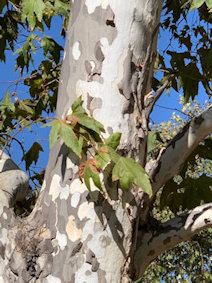

Sycamore Tree
Don’t touch these plants, but know them
Poison Oak grows as sprouts, a bush, or a vine; turns red in the fall and drops its leaves — but is always harmful to touch!
“Leaves of three; let it be”
“It’s no joke. It’s poison oak.”
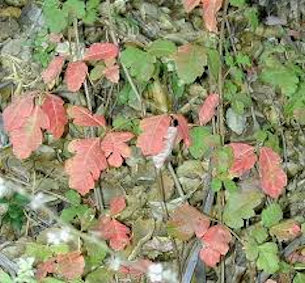
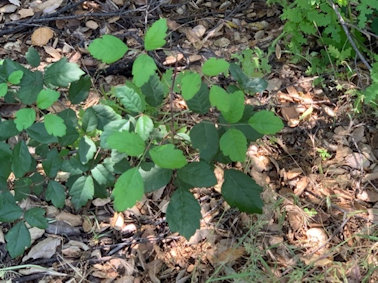


Stinging Nettle
Ouch!! The tips of those toothed points have a very irritating chemical that makes touching this plant extremely painful; it may even cause blisters. Stinging nettle is, however, very healthful when boiled and eaten as a vegetable. If you can get it to the cooking pot without it touching your skin, you will be rewarded with a great number of vitamins and minerals, and even protein, which is unusual to find in a green, leafy plant.


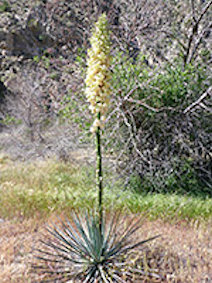
Yucca
Sharper than it looks!
With or without a single, tall stalk (which grows & flowers only once).
Spiky leaf fibers were used for rope, sandals, thread; roots were used as soap.
Prickly Pear – another “don’t touch!” plant
Prickly pear can store water in its green pads. Those pads are actually the plant’s stem (where it makes sugars; most plants do that in their leaves). What would be the leaves have actually become spines; no water will be escaping from them. Animals—and people—love the fruit.
Is there white, fuzzy stuff on it? That’s the foam protection of the tiny insect called cochineal. Cochineal has been used for centuries as a red dye. Here are a couple of them, magnified many times!
It’s OK to touch and smell the following plants
(but leave other plants alone; some can hurt you or activate allergies!)
White Sage
White sage is one of the fuzzy-leafed plants. Black sage (below) has darker, smaller leaves, but the same nice smell.




All OVER the place in spring!


All OVER the place in spring!

Because foraging mules could bloat from eating too much. Seen near the stream bed. Look for tiny veins along leaf edges.
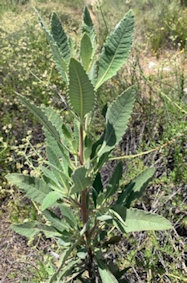
Yerba Santa has thick, serrated, fuzzy leaves (holds on to water!) Lower leaves may look dead and dry. Used by native people for many medicinal uses.

Mugwart handles heat in a special way: on hot days, its darkish-green leaves turn bottom-side up, which display white, a color that reflects heat away from the leaves.
A Few More Plants that are Fun to Learn About
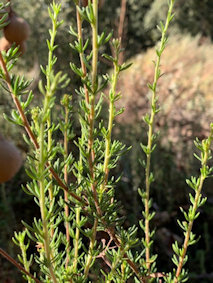
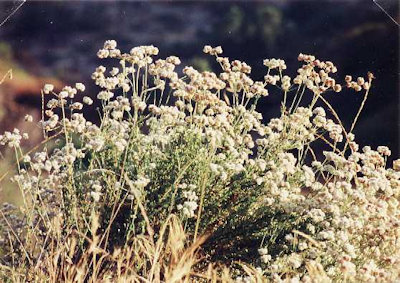

California (flat-topped) buckwheat, in bloom and with rusty autumn blossoms; note how the flower tops of each stalk end at almost the same level; thus the name “flat topped buckwheat.”


Dodder (or “witch’s hair”) Dodder doesn’t have green chlorophyll, so can’t make its own food as other plants can. It wraps around another plant—very often flat- topped buckwheat—to suck out the nutrients. It doesn’t hurt the plant, though.


Wild Cucumber. NOT for salads. It may have green, prickly fruits (poison!) or dried, empty seed pods. This vine uses tiny tendrils to climb other plants to reach the sun. Look for the tendrils that help it grab on.


Phacelia (fa-CEEL-ya), AKA caterpillar plant. Bees love its purple pollen! You can see the caterpillar shape even after it has dried out and looks gray/brown. Activates allergies for some.

Laurel Sumac
The “taco tree” (note leaf shape). Two laurel sumacs near the visitor center have large wood rat nests at their base. Also can be an allergen.
Did you come in the fall or winter?
Some plants are still busy, such as these late bloomers
(or dry-blossom-keepers)
For many plants, winter is a berry and seed season

Acorns that have fallen from live oaks.

No berries; just bare. Notice how Poison oak stems (don’t touch!) look somewhat vertical

California sagebrush smells nice when it’s dry. Scrunch a stem and see.
Four Common Lizards

Fence lizard
(maybe doing push-ups)

Alligator lizard
(often has zig-zag pattern)
Essential, Rodent-controlling snakes!
(if they are not in their winter sleep)

Gopher snake
(narrow head & pointed tail)

Rattlesnake
(wide head, blunt tail, rattles)
Neither snake is aggressive (and the gopher snake is harmless to humans). Both will try to flee; just give them space. People who get bitten by rattlesnakes are usually people who are fooling around with rattlesnakes! (The others have surprised them by stepping or reaching into a hidden place.)
These three snakes are also harmless to humans (in addition to the gopher snake).

Rattlesnake Tails
Fun fact: rattlesnake’s rattle looks snapped together (inside view). The looseness of the connection is what makes the rattling noise when the tail is shaken.

A Few Local Arthopods

Jumping spider

Garden spider

Box elder bug

Darkling beetle (stink bug)

Honeybee

Carpenter bee (shiny)

Bumblebee (fuzzy)

Bee fly

Fiery skipper

Cabbage white

Gulf fritillary

Mourning cloak
Thank you for taking the tour!
Get ready for your next visit to Eaton Canyon by checking out information about the geology, plants, animals, and history of the canyon at: ecnca.org, under the “Learn” menu.
More fun awaits under the “Children’s Activity Sheets” menu.
Photo contributors include Jeff & Wendy Photography, Chuck Haznedl,
Terry Keller, Helen Wong, Mickey Long, Mari Gavisheli, and Vadi Martirosyan



























